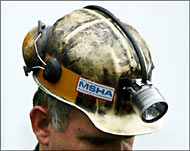US military eyes coal as fuel source
The Pentagon is trying to persuade investors and the energy industry to embrace an 80-year-old technology to turn coal into liquid fuel to power planes, tanks and other battlefield vehicles.

Officials have been crisscrossing the country, meeting energy companies and state government officials to sell them the idea. At the same time, military researchers have been testing fuel produced by the process to make sure it is suitable for military vehicles, especially older ones.
The military is worried that political pressure or terrorist acts could cut the flow of oil from the Middle East or hurricanes or terrorists could destroy US refineries.
William Harrison, the senior adviser for the Pentagon’s Assured Fuels Initiative, said: “We know what the technical challenges are, but we don’t see any show-stoppers. There is still a level of uncertainty, but it looks like the technology is mature enough.”
Building coal-to-fuel plants is expensive – possibly up to $5 billion. Investors worry that their money could go up in smoke if the global price of oil drops, budding government subsidies dry up, or tougher environmental rules are put into place, said Kevin Book, a senior analyst for Friedman, Billings, Ramsey & Co Inc.
Tremendous impact
But then there is coal – lots of it.
The Middle East has about 685 billion barrels of oil compared with 22 billion barrels in the United States. However, there is enough coal in the United States to produce 964 billion barrels of fuel, according to the Pentagon.
Montana, with enough coal to produce 240 billion barrels of fuel, leads the pack, followed by Illinois, Wyoming, West Virginia, Kentucky, Pennsylvania and Ohio.
 |
|
Montana state has the most |
Mike Carey, the president of the Ohio Coal Association, said: “We have probably 250 years’ worth of coal. It would have a tremendous impact on the coal industry.”
The industry is already on the rise.
Demand for US coal is expected to be a record 1.2 billion tons this year, up from 1.18 billion in 2005, according to the National Mining Association. Production is forecast to be 1.16 billion tons, a 3.2% increase over 2005.
Coal is used mainly to generate electricity and in steel-making. Although experts say the coal-to-fuel process works, it is being done in just a few small demonstration projects.
The Pentagon began looking at coal in 2001 when Congress earmarked $13 million to investigate the Fischer-Tropsch process in which coal is gasified and then liquefied into fuel. The technology was developed by Germany in the 1920s and used by South Africa beginning in the 1950s.
The military accounts for about 4% of US fuel consumption.
Cleaner fuel
The process promises to produce a cleaner fuel that gives off more energy per pound and is less subject to freezing. It would reduce transportation costs and ease logistical headaches by enabling the military to use one fuel for all of its aircraft and vehicles instead of the more than half dozen different fuels now used.
“See how beautifully clean that fuel is,” Harrison said, pointing to a dancing flame inside a large glass tube at a Wright-Patterson Air Force Base lab. The flame turned from orange to blue as the soot was reduced when the fire began to burn fuel similar to what would be produced from coal.
Harrison, chief of the Air Force’s fuels lab at the base, has been trying to light a fire in the private sector. He has spoken to state and industry officials in Ohio, West Virginia, Pennsylvania, Illinois, Montana and North Dakota.
Some energy companies are eager to have the military for a customer.
DKRW Energy in Texas hopes to begin producing coal-based diesel fuel in 2010. The company needs to complete the permitting process and obtain financing for a $1 billion plant that would produce 11,000 barrels of fuel a day in Wyoming.
Oklahoma-based Syntroleum converts natural gas into liquid fuels and is currently involved in several coal-to-fuel projects.
President Jack Holmes said increasing demand for oil should keep the price high and coal-based fuel attractive.
“We think that now’s the time,” Holmes said. “If we can get these first few plants built and running and get the acceptability in the government and industry, there’s a big market to do this.”
Others point out that similar talk in previous years evaporated when Middle East producers cut the price of oil.